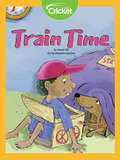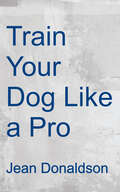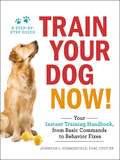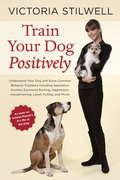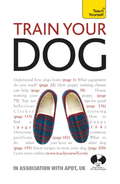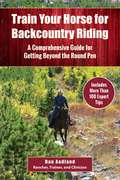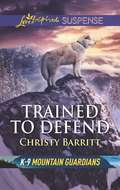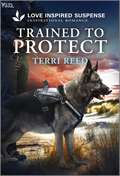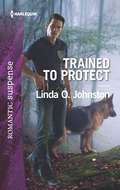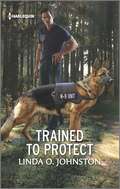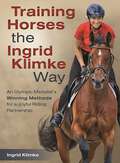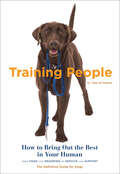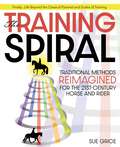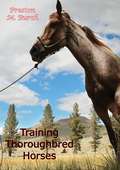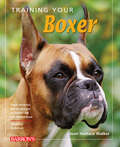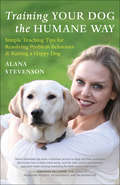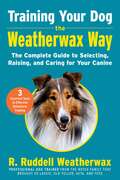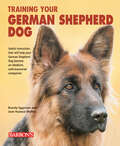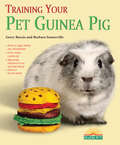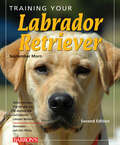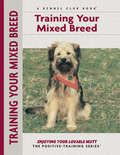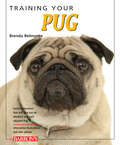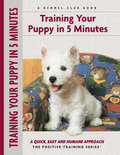- Table View
- List View
Train Time
by David HillPatrick is too excited to sleep! It’s the first day of vacation, and he can’t wait to pretend to drive a train around his room. The only problem is he keeps waking his family up! Will Patrick be able to get the train back to the “station” safely? Or will his family make him go back to bed?
Train Your Dog Like a Pro
by Jean DonaldsonJean Donaldson is one of the top dog trainers in the United States, and her training academy has gained a reputation as the Harvard for dog trainers and behavioral counselors. Now, you can harness her highly effective dog-training techniques and benefit from her expert guidance without leaving your home. <p><p>If you're like most dog owners, you treat your four-legged friend as a valued member of the family who enjoys the full run of the house—which is why good behavior is so important. Train Your Dog Like a Pro offers a trusted, systematic approach to positive dog training that anyone can follow. You'll get clear, detailed instructions for teaching essential behaviors, more advanced skills, and even some fun tricks. Plus, a bonus online video shows you exactly how to accomplish each technique.
Train Your Dog Now!: Your Instant Training Handbook, from Basic Commands to Behavior Fixes
by Jennifer L. SummerfieldPresenting a new way to work with your dog, with simple step-by-step instructions and lists to help you teach your dog the most important and necessary skills.Take your dog from wild to well-behaved in just a few steps! Train Your Dog Now! takes the best dog training tips, advice, and instructions and breaks them out into bite-sized pieces to help you—and your dog— learn everything you need to know, fast. With step-by-step instructions for teaching simple commands such as sit and drop it, guides for getting your dog used to new environments, as well as easy-to-follow instructions for teaching basic tricks and correcting bad behaviors, this book has everything you need for your pet. Lessons Include: 8 Steps to Housetraining 5 Steps to Curbing Destructive Chewing 7 Steps to Stop Your Dog from Jumping on People 3 Steps to Stop Pulling on the Leash 5 Steps to Curb Excessive Barking
Train Your Dog Positively
by Victoria StilwellVictoria Stilwell, positive reinforcement dog trainer and star of the hit Animal Planet TV show, It's Me or the Dog, explains how to use her force-free, scientifically-backed training methods to solve common canine behavior problems. Victoria Stilwell is one of the most well-loved and trusted names in America's pet media, winning over audiences with SuperNanny-like British mannerisms in her television show, which airs in more than 40 countries worldwide. By using positive reinforcement training methods, Victoria helps owners change the way their dog thinks, feels, and learns. With this upbeat, proven guide, Victoria will address the main problem behaviors that have dog owners wringing their hands in desperation, from submissive urination to separation anxiety to leash aggression to jumping up on visitors.
Train Your Dog Positively: Understand Your Dog and Solve Common Behavior Problems Including Separation Anxiety, Excessive Barking, Aggression, Housetraining, Leash Pulling, and More!
by Victoria StilwellVictoria Stilwell, positive reinforcement dog trainer and star of the hit Animal Planet TV show, It's Me or the Dog, explains how to use her force-free, scientifically-backed training methods to solve common canine behavior problems. Victoria Stilwell, America's favorite no-nonsense trainer, has rehabilitated some of the world's most difficult dogs- and now she's revealing her scientifically proven behavioral training secrets for you to use at home.Victoria's all-new training guide shows how positive reinforcement is more effectivethan other methods: by changing the way your dog thinks, feels, and learns, you can actually encourage your dog to want to behave. With tips and tricks for understanding canine language, harnessing the power of reward-based training, and tapping into dogs' natural instincts, there are no hopeless cases! So get ready to boost your dog's confidence, improve your communication, and build your bond with your best friend today.
Train Your Dog: Teach Yourself (Teach Yourself General)
by ApdtDo you want your dog to be socially well-behaved? Are you looking for advice on training and looking after your pet? Covering every aspect of kind, fair and effective dog training as well as authoritative advice on looking after your pet, Train Your Dog is essential reading for all dog owners or those thinking of getting a dog for the first time. Written by the APDT, a guarantee of quality in dog training, this book covers positive reward and motivational techniques that will ensure your dog is socially well-behaved, obedient and, most importantly, able to be a part of your family. It also details different training methods for different types of dog, issues to address before training commences (deciding on your commands and discovering the motivation of your dog), equipment that may aid the training experience and essential tips for training a puppy or a 'problem dog'. Packed full of essential advice on all aspects of being a dog owner, this book will ensure that you get the most out of your pet and vice versa! NOT GOT MUCH TIME? One, five and ten-minute introductions to key principles to get you started. AUTHOR INSIGHTS Lots of instant help with common problems and quick tips for success, based on the author's many years of experience. TEST YOURSELF Tests in the book and online to keep track of your progress. EXTEND YOUR KNOWLEDGE Extra online articles at www.teachyourself.com to give you a richer understanding of dog training. FIVE THINGS TO REMEMBER Quick refreshers to help you remember the key facts. TRY THIS Innovative exercises illustrate what you've learnt and how to use it.
Train Your Horse for the Backcountry: A Comprehensive Guide for Getting Beyond the Round Pen
by Dan AadlandMany clinicians offer strong instruction in building a relationship with the horse but too often exclude safety concerns and teaching the skills necessary for safe and fulfilling use in the backcountry. They don?t show students how to tie up a horse?s foot should you have to restrain him to pull porcupine quills, and they don?t teach basic knots and hitches. Enter Dan Aadland, a seasoned equestrian and breeder who shares expertise gained from riding backroads and teaching clinics. Aadland first teaches students to understand the natural impulses of the horse and how to stay safe, a method he calls ?survival horsemanship.? He then moves on to training both horse and rider in the basics of trail riding, including saddling, mounting with control, trail savvy, types of trails and obstacles, domestic and wild animal encounters, and staying cool in stressful situations. Other helpful topics covered include:Essential neck rein skills Elementary packing A mule primer Safe trailering Low-impact trail riding And much more! With Beyond the Round Pen, riders will be ready for safe backcountry exploring in no time.
Trained to Defend (K-9 Mountain Guardians)
by Christy Barritt“Take Buzz and run. Far away.…and don’t trust the police.”Framed for her boss’s murder, Sarah Peterson is on the run—with only her boss’s loyal husky, Buzz, for protection. To clear her name and keep her safe, she must rely on her ex-fiancé, former detective Colton Hawk. The police aren’t the only ones searching for Sarah and the brave dog…the real killer is on the hunt, determined to silence them for good.
Trained to Protect
by Terri ReedProtecting a witness could be a deadly mission for this K-9 team. K-9 officer Tarren McGregor never imagined that a cartel would find its way to Texas&’s South Padre Island—or target his best friend&’s sister. But when Julia Hamilton witnesses and prevents the kidnapping of a teen girl, Tarren knows that trouble is soon to follow. Because Julia didn&’t just protect the girl—she saw the abductor&’s face. Now she&’s marked for murder, and it&’s up to Tarren and his K-9 partner to keep Julia safe from the human traffickers in pursuit…even if it means putting themselves in the line of fire.From Love Inspired Suspense: Courage. Danger. Faith.
Trained to Protect (K-9 Ranch Rescue #2)
by Linda O. JohnstonA cop falls for the woman he’s sworn to protectA K-9 Ranch Rescue romanceFrom the moment Elissa Yorian arrives at Chance K-9 Ranch, an unknown foe has her in his sights. Fortunately, Officer Doug Murran is on the case. As he tracks Elissa’s mysterious enemy, he does his best to resist the electricity he feels every time he looks at her. Still, their passion might not be enough to protect Elissa from a murderer…
Trained to Protect: The Pregnant Colton Witness Rancher's Deadly Reunion Soldier Bodyguard Trained To Protect (K-9 Ranch Rescue Ser. #2)
by Linda O. JohnstonA cop falls for the woman he&’s sworn to protectA K-9 Ranch Rescue romance From the moment Elissa Yorian arrives at Chance K-9 Ranch, an unknown foe has her in his sights. Fortunately, Officer Doug Murran is on the case. As he tracks Elissa&’s mysterious enemy, he does his best to resist the electricity he feels every time he looks at her. Still, their passion might not be enough to protect Elissa from a murderer…
Training Dogs the Woodhouse Way
by Barbara WoodhouseThis is a delightful look at training dogs of all ages. The late Ms. Woodhouse explains it all with simplicity and humour.
Training Horses the Ingrid Klimke Way
by Ingrid KlimkeOlympic gold-medal-winner Ingrid Klimke was born under a bright star when it came to fulfilling dreams of equestrian greatness. Her father, Reiner Klimke, was an Olympic rider himself, and he instilled his principles of training and riding with the good of the horse in mind in his daughter at a young age. Ingrid has furthered her father's esteemed legacy, modernizing two of the classic works by her father—the bestsellingBasic Training of the Young HorseandCavalletti—and tirelessly championing a balanced, fair, and caring system of training the horse that ensures his physical and mental well-being even while preparing him for the very top levels of international competition.And now Ingrid has written a book of her own, detailing her personal system of bringing a horse along through the stages of progressive development, and providing readers guidelines and exercises to ensure success without stress at each milestone. The result is surely a joyful partnership between rider and horse that will go the distance.
Training People: How to Bring Out the Best in Your Human
by Tess of HelenaThis guide to choosing the right human for you and getting them to behave will have you howling with laughter—and rethinking obedience training.For centuries, dogs have known that they, not humans, run the show. But not all dogs know how to get the best from their people. Finally, from the leading expert in the field comes a straightforward, easy-to-use manual that’s written for dogs by a dog. This indispensable reference provides foolproof advice on obtaining everything a dog deserves, from the best food and exercise to grooming and chauffeur services. Here are all the tools a dog needs for selecting, training, and living with a well-behaved human.
Training Spiral
by Sue GriceEngaging new ways to understand and implement time-proven systems of horse training. The &“Scales of Training,&” &“Training Scale,&” and &“Training Pyramid&” are familiar terms to riders. Around the globe and across disciplines, equestrians hear reference to them or study them as a part of their equestrian education. Dressage rider and trainer Sue Grice grew up with these concepts, too, and like many, found them to be not only fairly boring, but also confusing when it came to actually implementing them as part of daily training. In the course of her work with other riders, she came to realize that although many seemed to know about the Scales of Training in theory, few actually applied them in practice. Grice determined that this was because there was really no clear framework or methodology for implementing the system in a progressive manner. So Grice conceived a new approach based on the standard but with a focus on a better rate of success. Success could be achieved when the rider was engaged with the system and understood how to continually adhere to it, even as advances (or falters) might occur. For over 30 years she has continued to develop and apply her ideas, and now she has finally brought them together to share with the world in this book. Here readers find a detailed plan for applying what Grice calls the &“Training Spiral.&” She does not try to rewrite what history has shown to work in the development of the riding horse, but instead simply provides a fresh framework that enables riders and trainers to: Apply the classical elements of the Training Scale in a more progressive and logical manner, and, Employ them systematically within daily training as well as over a longer period of time. Grice provides clear explanations of how to use each of the six elements (Rhythm, Suppleness, Contact, Impulsion, Straightness, and Collection), how the elements are to be used in order, and what can go wrong if they are applied in the wrong order. Clear examples are given at all levels of training, and detailed case studies demonstrate how the Training Spiral can succeed where traditional systems have failed. The spiral structure provides a means of applying the Scales of Training in practice that is not just logical but also extremely easy to follow. The clarity of Grice's approach also helps horses understand what is being asked of them, leading to a happier relationship between horses and riders, and training that progresses more quickly and easily overall. The Training Spiral is an invaluable and immensely practical guide for trainers and riders at all levels, from novice to advanced.
Training Thoroughbred Horses
by Preston M. BurchPreston M. Burch, considered one of America's most distinguished horsemen, summarizes his observations in this book in logical progression, for the benefit of both the novice horseman and the experienced professional.His approach to training Thoroughbreds is eminently practical, and readers will gain a new appreciation of the many details of racing stable operation.Training Thoroughbred Horses includes chapters on:The Selection of Racing MaterialBreaking YearlingsTraining 2-Year-OldsTraining 3-Year-Olds and Older HorsesThe Condition BookStable ManagementFeedingand many other aspects of the operation of a racing stable.
Training Your Boxer (Training Your Dog Series)
by Joan Hustace WalkerNoted for affectionate loyalty to their masters and their household, typical Boxers respond most readily to positive reinforcement techniques, such as clicker training. Inappropriate obedience training methods can often produce a stubborn and unwilling learner. This book, a title in B.E.S. Training Your Dog series, presents breed-specific advice to dog owners. The emphasis is on dog-friendly methods for teaching skills and preventing or correcting bad habits. Virtually every aspect of canine training is covered, including house training, teaching obedience to verbal cues and hand signals, retrieving, walking the dog on a leash, and more. Instructive color photos appear on most pages.
Training Your Dog the Humane Way
by Alana StevensonDog owners facing tough behavior problems and unique canine personalities need tips and techniques to make their lives better. And many are realizing that traditional training through punishment is unpleasant and potentially damaging to the dog -- and simply doesn't work long-term. With Training Your Dog the Humane Way, animal behaviorist and dog trainer Alana Stevenson provides dog owners with a simple, accessible guide to the most effective positive dog training techniques available. Alana presents easy-to-follow methods and advice for teaching dogs polite manners and resolving ongoing behavior issues. She provides solutions for such problems as housesoiling, play-biting, separation anxiety, fear of strangers, aggression, lunging while on leash, car sickness, and more. Readers will learn the most effective way to teach their dogs -- through kindness and benevolent leadership.
Training Your Dog the Weatherwax Way: The Complete Guide to Selecting, Raising, and Caring for Your Canine
by R. Ruddell WeatherwaxA training manual for any dog owner using the tried, true, and trusted Weatherwax methods. The name &“Weatherwax&” is widely known in the dog world. The author is a third-generation professional dog trainer and owner of Weatherwax Dog Training. The family has trained the original &“Lassie&” (actually a male named &“Pal&”), Toto for &“The Wizard of Oz,&” and also &“Old Yeller.&” These theories and tactics are applicable to any dog lover and owner, not just those on the big screen! This is a complete guide to dog ownership and basic training manual using the Weatherwax method, which hasn&’t changed in almost a century; though Robert has added a few enhancements over the years from his exposure to other great trainers. This book will teach readers to: Learn how to raise and train their dog using an approach customized to their dog&’s needs.Understand the correlation between our behavior and our dog&’s behavior.Implement techniques that will allow their dog to interact well in all situations. Find answers to the questions that plague the common dog owner.Train their dog the right way—from day one—as well as address any inherited behavioral issues.Send the right message to their dog, even when no verbal commands are being given.Alter the negative reaction their dog may have to certain situations.Understand the most appropriate tools for their own dog and dispel some of the rumors that exist regarding dogs in general.
Training Your German Shepherd Dog (Training Your Dog Series)
by Brandy Eggeman Joan Hustace Walker2018 Winner of the Dog Writers Association of America (DWAA) Award for Best Book on Training or Sports!First-time owners and dog lovers will rejoice at this veterinarian-approved dog training book! Training Your German Shepherd Dog provides advice on physical and behavioral characteristics you should look for when choosing a puppy, along with recommended training.Intelligent and quick learners, German shepherds are highly trainable, especially when starting early in life. German shepherds are wonderful companions for owners who can offer gentle, positive leadership and consistent training. As part of the B.E.S. Dog Bible series, Training Your German Shepherd Dog focuses on this unique breed, describing its physical traits, history, and behavior. Best of all, Training Your German Shepherd Dog provides essential training methods for owners! Important topics covered include:What to look for when choosing a puppy Living with a dog and understanding breed-specific traits Everyday care, grooming, and exercise Nutrition, health maintenance, and potential breed-specific health problems Training and play activitiesAll books in this dog training series are spiral bound and contain full-color photos. Informative sidebars are full of breed facts, helpful hints, and quick tips on training. Plus, every book comes with an instructional DVD with a dog training course for new owners!Want to learn about even more dog breeds?The B.E.S. Dog Bible series is a wonderful collection of titles focused on pairing owners with the best breed for their family, and training each breed in accordance with their characteristics. Other books in the series include, Boxers, Great Danes, Pugs, Golden Retrievers, Labrador Retrievers, Australian Shepherds, Pit Bulls, and more!
Training Your Guinea Pig (Training Your Pet Series)
by Gerry Bucsis Barbara SomervilleTraining Your Guinea Pig is for pet owners who seek detailed advice on how to get started in training their guinea pig. Guinea pigs are docile, easy to care for, and are capable of learning tricks. Teaching you first how to earn your guinea's trust and friendship, this relationship will be the building blocks to training tricks, enrichment games, and commands.Additional knowledge and advise in this book consists of the correct cage or DIY housing, toys and enrichment information, guinea language and communication, advise on getting all members of the household acquainted, and keeping a healthy and content guinea pig. The suggests activities within these pages will amuse both pet and owner and quickly become a trusted life-long resource for these unique and smart animals.
Training Your Labrador Retriever (Training Your Dog Series)
by September MornFirst-time puppy owners and dog lovers will rejoice at this veterinarian-approved dog handbook! Training Your Labrador Retriever provides advice on physical and behavioral characteristics to look for when choosing a puppy, along with recommended training.Good-natured and affectionate, Labrador Retrievers make wonderful pet companions. As part of the Training Your Dog series, Training Your Labrador Retriever focuses on this unique breed, describing its physical traits, history, and behavior. Best of all, Training Your Labrador Retriever provides essential training methods for owners! Important topics covered include:What to look for when choosing a puppyLiving with a dog and understanding breed-specific traitsEveryday care, grooming, and exerciseNutrition, health maintenance, and potential breed-specific health problemsPuppy and dog training, tricks, and play activitiesAll books in this dog training series are spiral bound and contain full-color photos. Informative sidebars are full of breed facts, helpful hints, and quick tips on training. Plus, every book comes with an instructional DVD with a dog training course for new owners!Want to learn about even more dog breeds?The Training Your Dog series is a wonderful collection of titles focused on pairing owners with the best breed for their family and training each breed in accordance with their characteristics. Other books in the series include, Boxers, Great Danes, Pugs, Golden Retrievers, Labrador Retrievers, Australian Shepherds, Pit Bulls, and more!
Training Your Mixed Breed
by Miriam Fields-Babineau Evan CohenFrom puppy to senior - and every stage of life in between - Positive-Training Series books offer fanciers savvy advice straight from the experts.
Training Your Pug (Training Your Dog Series)
by Brenda BelmonteIt's well known that each canine breed has its own traits, but when acquiring a new pet dog, many inexperienced owners mistakenly assume that the "one-size-fits-all" approach is adequate for purposes of dog training. This new title in B.E.S. Training Your Dog pet care series focuses on the distinctive traits of the Pug. Dog owners learn humane but effective methods of housebreaking and paper training, obedience training, teaching the dog to respond to verbal commands, walk on a leash, and more. All books in the Training Your Dog series are filled with instructive, step-by-step color photos that demonstrate training methods.
Training Your Puppy In 5 Minutes
by Miriam Fields-Babineau Evan CohenFrom puppy to senior - and every stage of life in between - Positive-Training Series books offer fanciers savvy advice straight from the experts.
